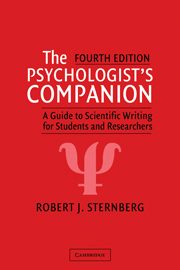Book contents
- Frontmatter
- Contents
- Acknowledgments
- Introduction
- 1 Eight Common Misconceptions about Psychology Papers
- 2 Steps in Writing the Library Research Paper
- 3 Steps in Writing the Experimental Research Paper
- 4 Rules for Writing the Psychology Paper
- 5 Using the Internet to Aid the Research Process
- 6 Commonly Misused Words
- 7 American Psychological Association Guidelines for Psychology Papers
- 8 Guidelines for Data Presentation
- 9 References for the Psychology Paper
- 10 Standards for Evaluating the Psychology Paper
- 11 Submitting a Paper to a Journal
- 12 How to Win Acceptances from Psychology Journals: Twenty-Nine Tips for Better Writing
- 13 Writing a Grant or Contract Proposal
- 14 How to Find a Book Publisher
- 15 Writing a Lecture
- 16 Article Writing 101
- References
- Appendix A Sample Psychology Paper
- Appendix B Writing for British and European Journals
- Index
3 - Steps in Writing the Experimental Research Paper
Published online by Cambridge University Press: 05 June 2012
- Frontmatter
- Contents
- Acknowledgments
- Introduction
- 1 Eight Common Misconceptions about Psychology Papers
- 2 Steps in Writing the Library Research Paper
- 3 Steps in Writing the Experimental Research Paper
- 4 Rules for Writing the Psychology Paper
- 5 Using the Internet to Aid the Research Process
- 6 Commonly Misused Words
- 7 American Psychological Association Guidelines for Psychology Papers
- 8 Guidelines for Data Presentation
- 9 References for the Psychology Paper
- 10 Standards for Evaluating the Psychology Paper
- 11 Submitting a Paper to a Journal
- 12 How to Win Acceptances from Psychology Journals: Twenty-Nine Tips for Better Writing
- 13 Writing a Grant or Contract Proposal
- 14 How to Find a Book Publisher
- 15 Writing a Lecture
- 16 Article Writing 101
- References
- Appendix A Sample Psychology Paper
- Appendix B Writing for British and European Journals
- Index
Summary
When a research psychologist talks about “writing a paper,” he is talking about a lengthy and complicated chain of events that includes a great deal more than just reporting research results. In this chapter I outline these events from start to finish.
PLANNING EXPERIMENTAL RESEARCH
Getting an Idea
For most psychology students, getting an idea for an experiment is the hardest part of research. There are no steps one can take that will guarantee generation of a good idea. The following suggestions may prove helpful, however.
Whom to Consult.
In many colleges and universities, the faculty is among the most underutilized of resources. In my first semester of teaching at Yale, I set aside three hours each week for “office hours.” I encouraged – sometimes I practically begged – students to come see me during these hours for advice on papers, projects, and the like. I left my door wide open to encourage students to enter. For the most part, though, I sat staring at the walls, or at the people scurrying by (but not in) the door. I also encouraged students to make individual appointments if they were unable to see me during my prearranged hours, but for the most part, students also failed to take me up on this offer. More recently, business has picked up, although much more so among graduate than among undergraduate students.
- Type
- Chapter
- Information
- The Psychologist's CompanionA Guide to Scientific Writing for Students and Researchers, pp. 35 - 64Publisher: Cambridge University PressPrint publication year: 2003



